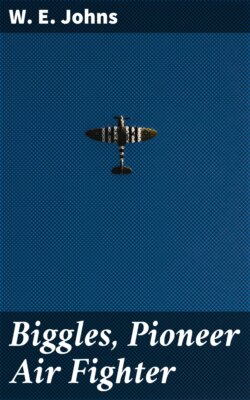Читать книгу Biggles, Pioneer Air Fighter - W E Johns - Страница 5
На сайте Литреса книга снята с продажи.
GLOSSARY OF TERMS USED IN THIS BOOK
ОглавлениеTable of Contents
Altimeter: The instrument used for determining the height of an aeroplane. It is not unlike a barometer, and is set in the instrument-board.
Ammonal: A very powerful explosive. It was used in Mills bombs.
Archie: The old Royal Flying Corps expression for anti-aircraft gun-fire. In World War II it became “flak”.
“Blipping”: The art of opening the throttle of a rotary engine in short, sharp bursts to keep it “alive”.
Bomb-Toggle: The bomb release handle.
Bowden Lever: The machine-guns of certain aeroplanes were fired by depressing a lever on the joystick. Sometimes a thumb button was used in the top of the joystick. Other methods were also employed according to the type of machine.
Brass-Hats: A common expression meaning staff officers, no doubt originating from the gold device on the peaks of their caps—often referred to as “bananas”.
Bristol Fighter: A famous type of two-seater British all-purpose aeroplane.
Buckingham: A type of incendiary bullet, calculated to set fire to anything it hit. They were used chiefly against lighter-than-air craft in order to set fire to the hydrogen gas with which these were inflated.
Camouflage: A word coined from the French, meaning “to conceal”, “disguise”, or make a thing look like something it was not. Many different forms of camouflage were employed during the war. Imitation grass mats, spread above guns, was known as camouflage. The painting of buildings, hangars and guns in sections of different colours, in order to break up their outlines, was also known as camouflage.
Centre Section: That part of the top plane of an aeroplane which comes immediately over the fuselage, and to which the wings themselves are joined.
Circus: Formations of enemy aeroplanes were commonly called circuses; often they were known by the name of the leader: thus “Richthofen’s circus”.
Cooper Bombs: Special bombs generally reckoned to weigh twenty pounds, although as a matter of fact they usually weighed about twenty-five pounds; often carried by single-seat fighters under the wings, four each side.
Deflection: The allowance made when shooting at a moving target. Briefly, it means shooting at the place where the target is expected to be when the missile reaches it.
Double-Frontiers: In order to prevent prisoners of war from escaping, the Germans, in many places, arranged artificial or false frontiers in order to lead escaping officers to believe that they had entered another country, whereas in fact they had not.
Fanning (Down): An R.F.C. expression for blowing up with bombs. Things were fanned down, not blown up.
Flaming Onions: Missiles used by the Germans against aeroplanes in World War I. The weapons that fired them remained a mystery until the end of the war. They appeared in a series of glowing balls of fire that rose vertically from the ground.
Flying Wire: Broadly speaking, the wings of biplanes were braced with two sorts of wires, flying wires and landing wires. Flying wires hold the wings in position in the air; landing wires take the weight of the wings when the machine is standing on the ground.
Hannoverana: An efficient type of German two-seater, 1917-18.
Inclinometer: An instrument very much like a spirit-level, set across the instrument board, the position of the bubble showing if the machine is flying level, or banking.
M.O.: Medical Officer.
“Nines”: De Havilland 9’s, famous 2-seater bombers, 1917-18.
Parachute Flares: Bright lights which had a parachute attachment in order that they should sink slowly to the ground. They were used by aeroplanes to illuminate the ground below them while night-flying.
Pour Vous: Words supposed to resemble the noise made by the German Mercédès aero-engine.
Rocking Wings: The signal usually employed (before the days of radio) by the leader of a formation to indicate that enemy aircraft were in sight or that he was going to attack.
Rumpler: A German two-seater aeroplane used in large quantities during the war.
“Sausage”: Kite balloons were sometimes called “sausages”. German balloons were sometimes referred to as Drachens.
“Shoot” (Artillery): A machine spotting for the artillery was said to be doing a “shoot”.
Sidcot (suit): A thick, padded overall garment worn by pilots.
Smudge Fire: A small fire usually kept alight on aerodromes to show landing machines the direction of the wind.
Spandaus: Many German machine-guns and bullets were made at Spandau, Germany. For this reason German machine-guns were often referred to as Spandaus.
Tarmac: The paved area in front of the hangars.
Triplane: An aeroplane having three wings is a triplane. During the war it usually meant the Fokker triplane; also called “Tripehound”. Sopwith triplanes were used by the British.
Very Pistol: A short, large-bore pistol used for firing signal lights.
